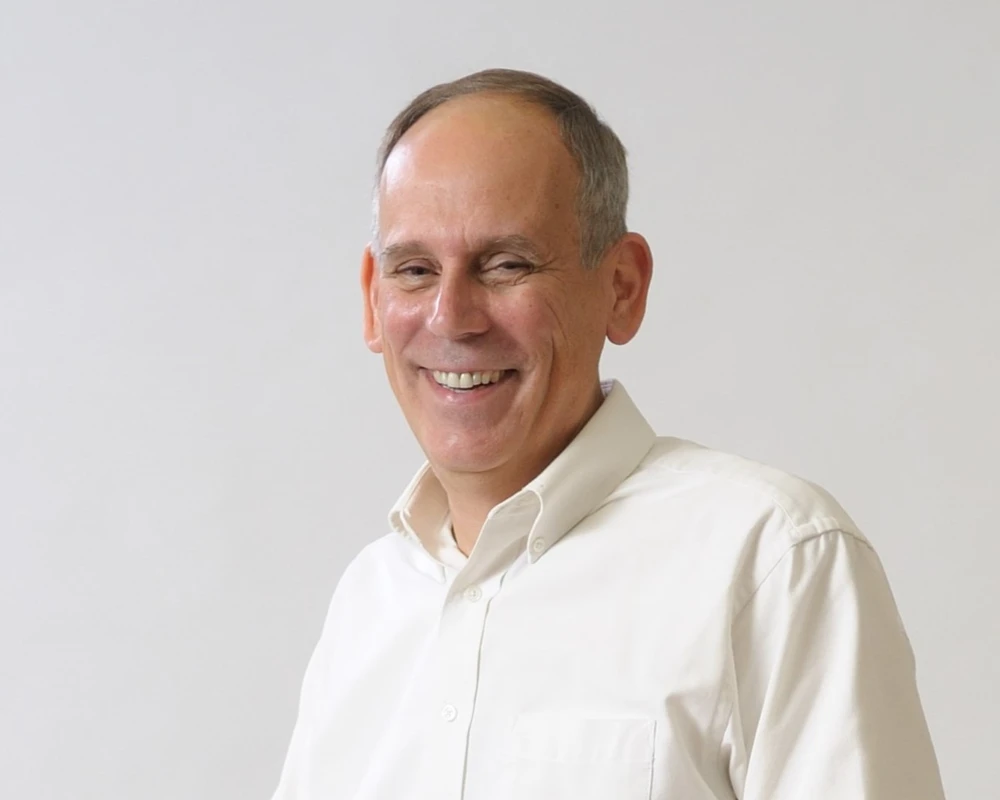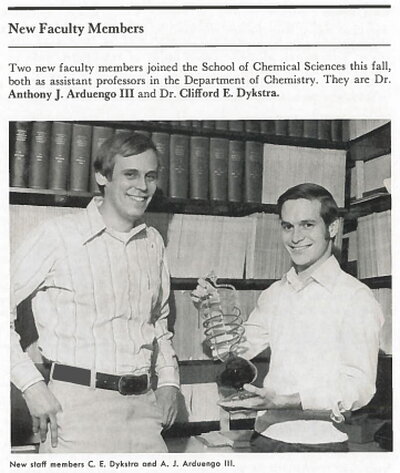
University of Illinois Alumnus and Professor Emeritus of Chemistry Clifford E. Dykstra (BS, ’73) passed away Jan. 18, 2025, at the age of 72.
A memorial service will be March 1 at the Arcola Presbyterian Church, 305 E. Jefferson St., Arcola, Illinois. The visitation will be 2-3 p.m. with a service to follow at 3 p.m. Prof. Dykstra married Dana Stowers in 1988; she survives him.
After graduating as valedictorian of Oaklawn High School in 1969, Prof. Dykstra attended the University of Illinois Urbana-Champaign and received degrees in chemistry and physics in 1973. He went on to earn his Ph.D. in chemistry in 1976 from the University of California at Berkeley under the direction of the theoretician Henry F. Schaefer.
Prof. Dykstra returned to the U. of I. to begin his academic career, joining the faculty in Fall 1977 as an assistant professor in the Department of Chemistry. A theoretical physical chemist, his early research interests focused on the quantum mechanics of molecular electronic structure, and he rose through the ranks to full professor.
In 1990, he moved to Indiana University-Purdue University Indianapolis, where he served as Associate Dean for Research and Graduate Programs for four years and where he was named a Chancellor's Professor in 2001. From 2006 through 2009, he was Chair of the Department of Chemistry at Illinois State University and then returned to the University of Illinois as a professor emeritus. Professor Dykstra was an Alfred P. Sloan Fellow, a Beckman Fellow in the Center for Advanced Study (Urbana), and a recipient of four awards for teaching excellence.
Professor Dykstra's research interests were in theoretical and computational chemistry. He used large-scale calculational approaches to simulate a variety of molecular phenomena, such as electron correlation effects in van der Waals and hydrogen bonded complexes and had a special interest in how molecules can attract one another without forming chemical bonds. He contributed to the methodology used for high-level determination of the distribution of electrons in molecules and for the evaluation of properties of individual molecules. He also worked on the development of models aimed at making the chemical problems associated with assembling molecules in large structures suitable for computational simulation. Over 200 research publications resulted from his work.
He served on the Editorial Board of Chemical Physics Letters for 21 years and was Editor of the Journal of Molecular Structure-Theochem, now Computational and Theoretical Chemistry, from 1993 to 2014. He was the author of two textbooks, Quantum Chemistry and Molecular Spectroscopy (1992) and Introduction to Quantum Chemistry (1993) and co-edited the book Theory and Applications of Computational Chemistry: The First Forty Years.
Memories of Prof. Dykstra from colleagues and alumni

in a 1977 edition of the School of Chemical Sciences newsletter.
Professor Emeritus of Chemistry Martin Gruebele
When Prof. Gruebele joined the Illinois chemistry faculty in the 1990s, he said he had heard about Prof. Dykstra’s work.
“I was delighted when he returned to town years later and we chatted at physical chemistry faculty meetings. His work on ‘coupled clusters’ of electrons pushed its applicability ahead compared to the ‘CEPA’ approximation in use at the time. And his method for obtaining derivatives of the wavefunction enabled calculation of many physically interesting quantities inaccessible for computation at the time,” Gruebele said.
Professor Emeritus of Chemistry James M. Lisy
Prof. Lisy said he and Prof. Dykstra collaborated almost immediately as Illinois chemistry faculty, especially once Lisy’s apparatus came on-line in 1983. Their collaboration “was extremely fruitful,” resulting in five joint publications from 1984 to 2000.
Prof. Lisy also recalls an interesting road trip from Geneva to Rome in the late 80s that he took with Prof. Dykstra and one of Cliff’s PhD students, Shi-Yi Liu.
“We rented a car and unexpectedly drove all night. Cliff and I shared the driving and Shi-Yi kept us awake until we arrived in Rome. We had dinner at the Volpe Bleu near the Plazza Venicia, and to the delight of the host, we returned a week later after our conference south of Rome. The host created a special dinner off the menu for us. It was a very memorable experience for us,” Lisy said.
Professor Emeritus of Chemistry J. Douglas McDonald
Professor McDonald said he especially remembers Cliff as one of his undergraduate students in the chemistry courses he taught, because Cliff was a very bright student and appreciated his teaching.
Scott E. Denmark, Reynold C. Fuson Professor of Chemistry
Prof. Denmark said he published a paper with Prof. Dykstra in 1987 on quantum mechanical calculations of the relative energies and barriers of interconversion of some simple phosphorus compounds.
“The work was initiated and carried out by a brilliant graduate student of mine named Christopher J. Cramer. Chris felt restricted by the experimental work he was doing with me and sought out Cliff for supervision on applying quantum chemistry to his thesis work. He also needed a less demanding advisor to neutralize my youthful excesses. Cliff was a perfect match for this effort, thoughtful, thorough, and patient.”
Denmark added that Cramer subsequently became a world-renowned quantum chemist at the University of Minnesota rising to the position of Vice President for Research and wrote a definitive textbook on Essentials of Computational Chemistry: Theories and Models.
“His career was clearly launched and inspired by Cliff,” Denmark said.
Alumnus Christopher J. Cramer (Ph.D., ’88, Denmark) Interim President and Chief Research Officer, UL Research Institutes
Cramer, who expressed sadness learning of Prof. Dykstra’s passing, said Prof. Dykstra played a key role in his professional development at Illinois.
“In 1986, as an organic chemistry graduate student in Prof. Scott Denmark’s group, Cliff allowed me to audit his class in Electronic Structure Theory. I had been seeing papers in the literature illustrating the power of theory for rationalizing organic reactivity and I wanted to learn more – and his lectures convinced me that I very much wanted to put theory’s formality into practice! [As an aside, I was so inspired by Cliff’s class that I decided to teach the Denmark group Hartree-Fock theory at one of its then infamous four-hour Tuesday night group meetings. I’m not sure I was ever forgiven for choosing that particular topic, although my decision to bring steak tartare as the mid-meeting snack may also have contributed considerably to the overall dismay].
At my request, Cliff next agreed to serve as an informal co-advisor on a project Scott and I proposed to him that involved modeling the isomerization of H3PO (phosphine oxide) to H2POH (phosphinous acid). I ended up performing approximate coupled-cluster calculations with a triple-zeta basis set, including by-hand geometry optimizations (quite an undertaking in 1986!), and we ultimately published a nice paper on the topic in Chemical Physics Letters early the next year.
Throughout the process of learning to run the calculations, Cliff made himself readily available to me, corrected my rookie mistakes, and helped me continue to expand my understanding of all the things that theory could do. It changed my life. After graduation and a few years of active-duty military service, I went on to spend 30 years as a faculty member in theoretical chemistry at the University of Minnesota, and my work with Cliff was the spark that helped to launch me on that career.
I kept in sporadic touch with Cliff over the years. In 2005, he invited me and several other theorists from around the world to visit him at IUPUI, to which he had moved several years previously. He had just received a distinguished professorship and had chosen to use the funds associated with that award to bring us all together for a few days to brainstorm on how quantum mechanical methods could be further developed to find improved applications in fields ranging from materials science to molecular biology. Cliff’s intellectual curiosity, his gentle sense of humor, and his appreciation for collegial engagement made the gathering a wonderful experience for all involved, and in addition to publishing a perspective together, all of us left armed with new ideas to further evolve our own research endeavors – just as I did from my first encounter with Cliff, lo those many years before.
I offer my condolences to Cliff’s family and friends, and I hope that these memories will resonate with those of others who found him a warm colleague, a kind friend, and an inspiring mentor.”
Alumna Shi-Yi Liu (Ph.D. ’87, Dykstra), retired, Senior Management, Schrödinger, Inc.
Shi-Yi Liu co-published 14 papers with Prof. Dykstra during Liu’s time in his research group at Illinois. Liu’s research was recognized by the Sigma Xi student research award (1st place) in 1986, as well as the Division of Physical Chemistry Award from the ACS. Liu was also invited to the NATO Advanced Research Conference to present research.
“All of which would not have been possible had Cliff not pushed me, as he did all his students. His mentorship may have felt challenging at the time, but I have grown to truly appreciate and be grateful for it in my life since,” Liu said. “Cliff's exacting standards brought out excellence in us that we didn't even know we possessed.”
After graduating from Illinois, Liu went into industry, at Allied-Signal, but then had the rare opportunity to continue working in computational chemistry at Schrödinger, Inc., near family in Portland, Oregon. In 2021, Liu retired from senior management at Schrödinger, Inc., after 24 years at the scientific software and biotechnology company that specializes in developing computational tools and software for drug discovery and materials science. Liu kept in touch with Prof. Dykstra through the years.
Larry Nelson, retired IT professional, University of Illinois Urbana-Champaign
As a computer programmer, consultant, and systems manager in the School of Chemical Sciences Computer Center from 1972 to 1988, Larry Nelson worked with Prof. Dykstra on computer related projects.
Nelson said Prof. Dykstra was an adamant proponent of bringing enhanced on-site computational resources to the Chemistry Computer Center in 151 Noyes Lab as well as for his own research group, particularly, an FPS Array Processor to attach to the Center's VAX 11/780 computer and a VAX 11/750 for his group. Nelson said he and Dykstra worked together to plan, implement, and maintain those hardware and software resources.
“Outside of the work environment, my wife and I became good friends with Cliff and his wife, Dana, sharing many common interests including horses, our respective rural properties, starting vineyards, cooking, art, and sharing wonderful meals, wine, and philosophical discussions,” Nelson said.